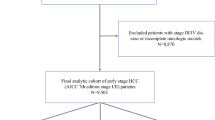Abstract
Background
Previous database studies have found gender disparities favoring men in rates of liver transplantation, which resolve in cohorts examining only patients with hepatocellular carcinoma (HCC).
Aims
Our study aims to use two large, multicenter United States (US) databases to assess for gender disparity in HCC treatment regardless of transplant listing status.
Methods
We performed a retrospective database analysis of inpatient admission data from the University Health Consortium (UHC) and the Nationwide Inpatient Sample (NIS), over a 9- and 10-year period, respectively. Adults with a primary discharge diagnosis of HCC, identified using the International Classification of Diseases 9th Edition (ICD-9) code, were included. Series of univariate and multivariate analyses were performed to examine gender disparities in metastasis, liver decompensation, treatment type, and inpatient mortality after controlling for other possible predictors.
Results
We included 26,054 discharges from the NIS database and 25,671 patients from the UHC database in the analysis. Women with HCC appear to present less often with decompensated liver disease (OR = 0.79, p < 0.001). Furthermore they are more likely to receive invasive HCC treatment, with significantly higher rates of resection across race and diagnoses (OR = 1.34 and 1.44, p < 0.001). Univariate analyses show that US women have lower unadjusted rates of transplant; however, the disparity resolves after controlling for other clinical and demographic factors.
Conclusions
US women more often receive invasive treatment for HCC (especially resection) than US men with no observed disparity in transplantation rates when adjusted for pre-treatment variables.

Similar content being viewed by others
References
Ferlay J, Shin HR, Bray F, Forman D, Mathers C, Parkin DM. Estimates of worldwide burden of cancer in 2008: GLOBOCAN 2008. Int J Cancer. 2010;127:2893–2917.
El-Serag HB. Hepatocellular carcinoma. N Engl J Med. 2011;365:1118–1127.
Fattovich G, Stroffolini T, Zagni I, Donato F. Hepatocellular carcinoma in cirrhosis: Incidence and risk factors. Gastroenterology. 2004;127:S35–S50.
de Lope CR, Tremosini S, Forner A, Reig M, Bruix J. Management of HCC. J Hepatol. 2012;56:S75–S87.
Bruix J, Sherman M. Practice guidelines committee AeAftSoLD: Management of hepatocellular carcinoma. Hepatology. 2005;42:1208–1236.
Bruix J, Sherman M. Diseases AAftSoL: Management of hepatocellular carcinoma: An update. Hepatology. 2011;53:1020–1022.
Forner A, Reig ME, de Lope CR, Bruix J. Current strategy for staging and treatment: The BCLC update and future prospects. Semin Liver Dis. 2010;30:61–74.
Moylan CA, Brady CW, Johnson JL, Smith AD, Tuttle-Newhall JE, Muir AJ. Disparities in liver transplantation before and after introduction of the MELD score. JAMA. 2008;300:2371–2378.
University Health Consortium, (HCUP) HCaUP: National inpatient sample. http://www.uhc.edu. Accessed 5 September 2011.
Healthcare Cost and Utilization Project (HCUP) HCaUP. National Inpatient Sample. http://www.hcup-us.ahrq.gov/nisoverview.jsp. Accessed 4 September 2011.
Charlson ME, Pompei P, Ales KL, MacKenzie CR. A new method of classifying prognostic comorbidity in longitudinal studies: Development and validation. J Chronic Dis. 1987;40:373–383.
Deyo RA, Cherkin DC, Ciol MA. Adapting a clinical comorbidity index for use with ICD-9-CM administrative databases. J Clin Epidemiol. 1992;45:613–619.
Shavers VL, Harlan LC, Stevens JL. Racial/ethnic variation in clinical presentation, treatment, and survival among breast cancer patients under age 35. Cancer. 2003;97:134–147.
Simons JP, Ng SC, Hill JS, Shah SA, Zhou Z, Tseng JF. In-hospital mortality from liver resection for hepatocellular carcinoma: A simple risk score. Cancer. 2010;116:1733–1738.
Singal AG, Chan V, Getachew Y, Guerrero R, Reisch JS, Cuthbert JA. Predictors of liver transplant eligibility for patients with hepatocellular carcinoma in a safety net hospital. Dig Dis Sci. 2012;57:580–586.
Dohmen K, Shigematsu H, Irie K, Ishibashi H. Longer survival in female than male with hepatocellular carcinoma. J Gastroenterol Hepatol. 2003;18:267–272.
Kalra M, Mayes J, Assefa S, Kaul AK, Kaul R. Role of sex steroid receptors in pathobiology of hepatocellular carcinoma. World J Gastroenterol. 2008;14:5945–5961.
Mindikoglu AL, Regev A, Seliger SL, Magder LS. Gender disparity in liver transplant waiting-list mortality: The importance of kidney function. Liver Transpl. 2010;16:1147–1157.
Cholongitas E, Marelli L, Kerry A, et al. Female liver transplant recipients with the same GFR as male recipients have lower MELD scores—a systematic bias. Am J Transplant. 2007;7:685–692.
Myers RP, Shaheen AA, Aspinall AI, Quinn RR, Burak KW. Gender, renal function, and outcomes on the liver transplant waiting list: Assessment of revised MELD including estimated glomerular filtration rate. J Hepatol. 2011;54:462–470.
Farinati F, Sergio A, Giacomin A, et al. Is female sex a significant favorable prognostic factor in hepatocellular carcinoma? Eur J Gastroenterol Hepatol. 2009;21:1212–1218.
Conflict of interest
None.
Author information
Authors and Affiliations
Corresponding author
Appendix
Appendix
Rights and permissions
About this article
Cite this article
Cauble, S., Abbas, A., Balart, L. et al. United States Women Receive More Curative Treatment for Hepatocellular Carcinoma Than Men. Dig Dis Sci 58, 2817–2825 (2013). https://doi.org/10.1007/s10620-013-2731-9
Received:
Accepted:
Published:
Issue Date:
DOI: https://doi.org/10.1007/s10620-013-2731-9





